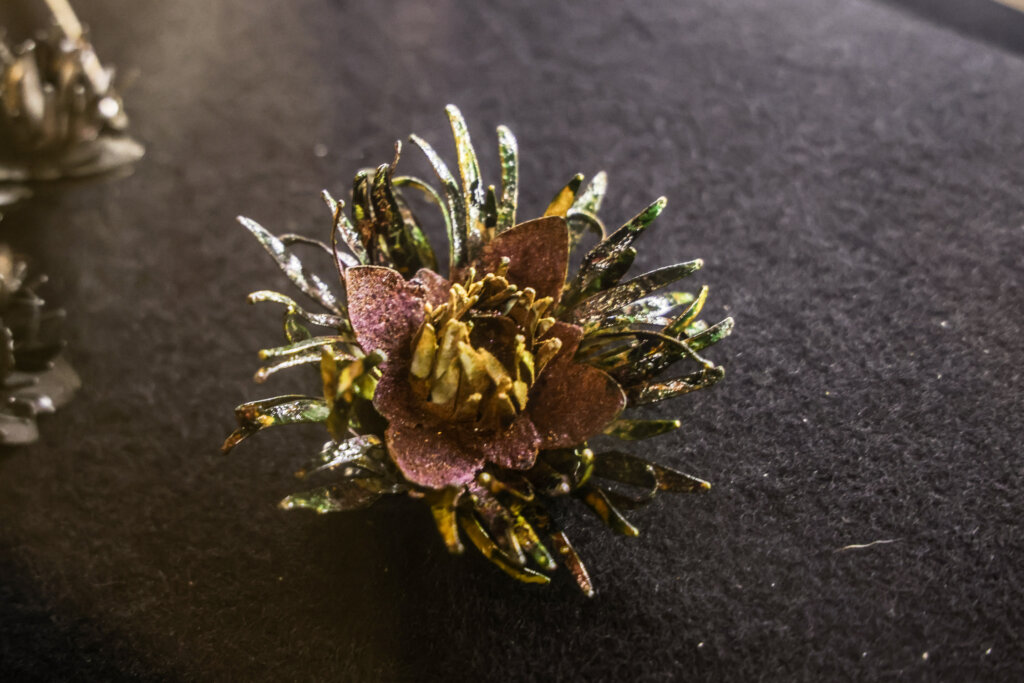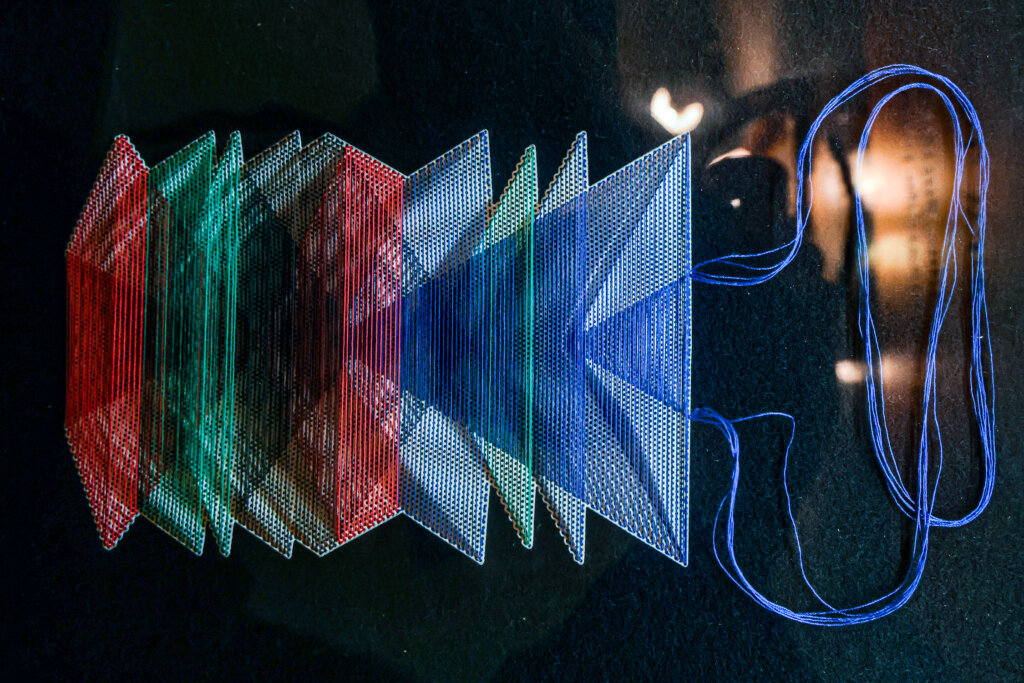In Israeli jewelry, a profound meditation on life in a militarized society
A show at 92NY comes just weeks after the Y’s Poetry Center canceled the talk of a pro-Palestinian author

Rachel Dahan Taanach. Dependence 4. Brass, paper, Teflon string. Photo by Vladimir Kolesnikov/Michael Priest Photography
To visit the opening reception for 92NY’s jewelry exhibit, I had to be personally invited, walk between NYPD officers and through a metal detector, and tell security guards where I was going. When I arrived at the building’s Hall of Mirrors, the vaulted, polished stone space was lively, but not crowded. Clusters of visitors dotted the hall, peering over display cases of jewelry full of bold lines, contrasting colors, and disparate materials, like the metal from a smashed can affixed with silver and gemstones.
Jewelry Center director Jonathan Wahl said that 92NY was quieter than usual in its promotion of Between Edges: Israeli Contemporary Jewelry, a one-week exhibition of the work of Israeli jewelry designers, because of anxieties surrounding the war between Israel and Hamas. The show also came a few weeks after the 149-year-old institution found itself embroiled in controversy due to its censorship of a pro-Palestinian author scheduled to speak at the Poetry Center.
It’s a shame that the show didn’t receive bolder promotion or a longer run. The world missed out on jewelry that offers striking, vulnerable commentary on life in a militarized society. Gillian Golan, the show’s co-curator and a lecturer at Israel’s Shenkar College of Engineering, Design, and Art, shaped Between Edges to portray what she said is a distinct Israeli design aesthetic stemming from the ever-present tension within Israel and between Israel and its neighbors.

In one display, a polymer bracelet shaped like a human heart features a gaping hole just large enough for someone to place around their wrist. Next to it, Omer Ader’s necklace Anthropocene — a name for the present geological age dominated by humans — announces itself to visitors as a giant black question mark that can be hung around a person’s neck.
As I wandered through the exhibit, I was struck by how many of the pieces called attention to the specter of war. In dependence 4, Rachel Dahan Taanach made blue Teflon string necklaces affixed to brass bullets pierced through pieces of paper. She overlaid the paper with rocklike shapes that, when viewed at an angle, look like hearts. The pendants, quiet and spare, seem to question humanity’s dependence on warfare, and the relationship between that violence and the earth beneath our feet.
In Vulnerability Medals, Noga Harel upends the custom of awarding strips of fabric attached to medals to valorous soldiers. Instead, she celebrates vulnerability, embroidering swaths of white silk with flora and fauna and attaching them to polymer recreations of endangered coral.

Most of the work on display was made and selected before Oct. 7, when Hamas terrorist attacks claimed the lives of over 1,200 people in Israel, prompting a siege on Gaza that has now killed more than 11,000 Palestinians, according to local officials in the territory controlled by Hamas. “Oh my God, I can’t believe how relevant it is,” Golan said.
A good deal of the work is not explicitly political, but remains audacious: a necklace made of purple, green, and yellow balloons; red beads attached to white ceramics that look like the cross sections of a bone.
She and Wahl, who co-curated the exhibit, have talked about exhibiting Israeli jewelry since the first NYC Jewelry Week in 2018. Their dreams were finally set to come to fruition this year, but in the last month, the war threatened to upend their plans. “We weren’t sure it was going to happen,” Wahl said. “We weren’t sure that she was gonna be able to fly. We weren’t sure she was going to be able to get all the work.”

“The artists really pushed me to do it,” said Golan. “They said, ‘What do you mean? You must do this. That’s the only thing we have left — is making art, and creation, and showing the light.’”
Even with Golan’s buy-in, Wahl said that there was some hesitation at 92NY over promoting the show. “Because of what Israel is going through, and also, at this moment, what the world is going through,” said Wahl. “Antisemitism, anti-Islam: There’s so many currents that we didn’t really know what to do with.”
Wahl told me that the recent controversy at 92NY’s Unterberg Poetry Center had little bearing on their decision to give the show a quieter opening, saying the move was “really about the global environment.”

Whatever the source of the Jewelry Center’s anxiety, the jewelry they displayed was anything but timid: a necklace called Outburst #1 with a blue-and-white pendant depicting a bird call; metallic flowers that looked as if they’d just been burnt in a fire; nipple rings that embodied a Druze artist’s dance between tradition and modernity.
“I wanted to expose Israeli art,” Golan said, adding that she had no ideological agenda in curating the exhibit. “I came from the material, in the process of design, because I’m a designer. And all of this political stuff came on top of it.”
Still, one piece in particular has etched itself into my mind: Dana Hakim Bercovich’s Meeting on the Fence, which features an iron mesh pendant with the colors of the Israeli and Palestinian flags overlaid on one another. During wartime, to wear such a thing around one’s neck — in Israel, Palestine, or the United States — would be brave indeed.























